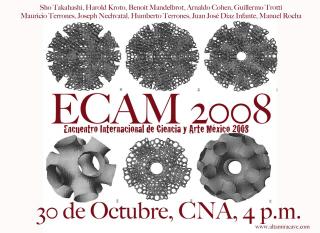 ECAM 2008 conference in Mexico City
ECAM 2008 conference in Mexico City
Cybism @ ECAM 2008 Mexico City
These brief words are an attempt to outline for ECAM 2008 what I am calling Cybism by stating what I take to be its underlying attributes.
Cybism is a new sensibility emerging in art respecting the integration of certain aspects of science, technology and consciousness – a consciousness struggling to attend to the prevailing current spirit of our age. This cybistic zeitgeist I identify as being precisely a quality-of-life desire in which everything, everywhere, all at once is connected in a rhizomatic web of communication. Therefore, cybism is no longer content with the regurgitation of standardized repertoires. Rather I detect in art a fertile attraction towards the abstractions of advanced scientific discovery - discovery now stripped of its fundamentally reductive logical methodology.
Moreover, cybism can be used to characterize a certain group of researchers and their understanding of where cultural space is developing today. Cybists reflect on system dynamics with a hybrid blending (cybridization) of the computational supplied virtual with the analog. Digitization is a key metaphor for the cybists only in the sense that it is the fundamental translating system today.
This blending of the computational virtual with the analog indicates the subsequent emergence of a new cybrid topological cognitive-vision that I have called the ‘viractual’: the space of connection betwixt the computed virtual and the uncomputed corporeal (actual) world which merge in cybism. This cybrid space of cybism can be further inscribed as a span of liminality, which according to the anthropologist Arnold van Gennep (based on his anthropological studies of social rites of passage) is the condition of being on a threshold between spaces.
Concerning this cybrid topological cognitive-vision, I am reminded here of two very different, yet complimentary, concepts: entrainment and égréore. Entrainment, in electro-physics, is the coupling of two or more oscillators as they lock into a commonly sensed interacting frequency. In alchemical terms an égréore (an old form of the word agréger) is a third concept or phenomenon that is established from conjoining two different elements together. I suggest that the term (concept) cybrid (and cybism) may be a concordant entrainment/égréore conception helpful in defining this third fused inter-spatiality that is forged from the meeting of the virtual and the actual.
Co-extensive notions found in cybism have piquant ramifications for art as product in that the cybists are actively exploring the frontiers of science/technology research so as to become culturally aware of the biases of consciousness in order to amend those biases through the monumentality and permanency which can be found in powerful art. They begin with the realization that every [new] technology disrupts the previous rhythms of consciousness. Then, generally speaking, they pursue their work in an effort to contradict the dominant clichés of our time, as they tend to move in their regimented grooves of sensibility. In this sense their art research begins where the hard science/technology ends.
Most certainly cybists understand that in every era the attempt must be made anew to wrest tradition away from a conformism that is about to overpower it. Hence the role of the cybist is that of the explorer/researcher. The function of such an explorationaly inclined artist however is not to only find, but to participate in and foster a constant instability of consciousness, to mitigate against self-stabilizing formations so as to encourage internal ‘cybomatic’ connections to sprout and expand. This integration goes far towards exemplifying an aesthetic that has a problematic relationship to material science-based reality.
Today, with the emergence and continual growth of cyberspace, it seems that no sense of closure will ever be able to contain the deterritorialization articulated and monumentalized by cybism.
Consequently, cybism has begun articulating a new techno-digital sense of life. By looking at the complex social and technological changes already occurring within the 21st century, cybists seem to perceive the world now as a kaleidoscopic environment in which every tradition has some valid residual form as information and sensation. A world of perpetual transformation has emerged and established a seemingly unrestricted area of abundant options.
| Attachment | Size |
|---|---|
| Invitación cienciay arte.jpg | 214.1 KB |
newmediafix.net
published at: http://newmediafix.net/daily/?p=2284